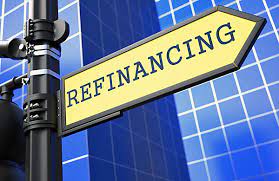Refinancing a loan or credit account, such as a mortgage, personal loan, or vehicle loan, is a popular approach to get a bigger discount. However, this guide will help you to know what does it mean to refinance a loan, how refinancing does work with bad credit, its cost, and how it hurt your credit.
Let’s begin.
Refinancing A Loan
Refinancing is the process of altering and modifying the terms of an existing credit agreement, most importantly a loan or mortgage. When a business or individual refinances a credit debt, they are generally aiming to better their interest rate, payment schedule, and/or other contract terms.
On the other hand, loan refinancing is the process of obtaining a new loan in order to repay one or more previous loans. Typically, borrowers refinance to achieve lower interest rates or to reduce the amount of money they must repay. For debtors who are having difficulty repaying their loans, refinancing can also be used to acquire a longer-term loan with reduced monthly payments. Due to the fact that interest must be paid over a longer period of time in certain situations, the total amount paid will increase.
What is Refinancing a loan?
A borrower can refinance a loan in order to replace their current financial obligation with a more favorable one. Through this strategy, a borrower obtains a new loan to pay off their existing debt, and the terms of the previous loan are replaced by the terms of the new loan. Borrowers can refinance their loans to obtain a lower monthly payment, a longer repayment period, or a more convenient payment plan. On the other hand, refinancing loans, such as mortgages and auto loans, typically have slightly higher interest rates than purchase loans.
Additionally, borrowers might refinance their debts in order to pay them off more quickly. While longer periods may result in cheaper monthly payments, they may result in a higher overall cost as a result of the additional time the loan accrues interest. However, because some loans, such as mortgages and auto loans, contain prepayment penalties, the benefit of refinancing may be offset by the increased charge.
Advantages of Refinancing:
- You can reduce your monthly payments if you refinance into a loan with a lower interest rate than your current one. This could be because you qualify for a cheaper rate as a result of market conditions or a higher credit score, which was not there at the time you borrowed. Reduced interest rates, particularly on large or long-term loans, typically result in substantial savings during the loan’s life.
- You can prolong payments by extending the period of the loan, but you will almost certainly pay more in interest. Additionally, you can refinance into a shorter-term loan to pay it off faster. For instance, you may refinance a 30-year mortgage into a 15-year mortgage, which would need higher monthly payments but would offer a lower interest rate. You’d repay the loan in 15 years rather than 30.
- Consolidating many loans into a single one may make sense if you can obtain a lower interest rate than you are now paying. Additionally, when you only have one loan, it’s simple to keep track of payments.
Disadvantages of Refinancing:
- It can be quite expensive. Refinancing rates vary by lender and jurisdiction, but you can anticipate paying between 3% and 6% of the outstanding debt in refinancing fees. Application, origination, appraisal, and inspection fees are just a few examples of additional closing charges. Closing costs on large loans, such as mortgages, can easily exceed thousands of dollars.
- Spreading out your loan payments over a longer period of time results in a higher interest rate on your debt. You may reduce your monthly payments, but the reduced monthly payments may be offset by the loan’s longer-term borrowing expenses.
- Certain loans offer essential advantages that will be lost if you refinance. For instance, if you run into financial troubles, federal student loans offer more flexibility than private student loans, including deferment or forbearance alternatives that temporarily suspend payment. If you work in the public sector, you may be eligible for partial forgiveness of your federal obligations. You may be better off sticking to this kind of favorable loan.
What Does Refinancing A Loan Mean?
Refinancing your loan means exchanging your old loan for a new one that may be for a larger amount.
When you refinance your mortgage, your bank or lender repays your prior loan and replaces it with a new one; thus, the name “refinance.” The majority of borrowers refinance in order to reduce their interest rate and shorten their payment term, or to cash out some of their home’s equity.
The two basic types of refinancing are rate and term refinancing and cash-out refinancing.
#1. Rata and Term Refinance
A rate and term refinance results in the acquisition of a new loan with a lower interest rate and, in some situations, a shorter payment term (30 years changed to 15 years term).
With current record-low interest rates, refinancing a 30-year loan into a 15-year loan may result in identical monthly payments to the original loan. This is because your new loan has a lower interest rate, even though 15-year debt payments are normally higher than 30-year mortgage payments.
#2. Cash-Out Refinance
With a cash-out refinance, you can borrow up to 80% of the current value of your home. As a result, this type of refinancing is referred to as a cash-out refinance. Assume your property is worth $100,000 and you owe a mortgage of $60,000 on it. As a qualified borrower, your bank or lender may offer you a cash-out of up to $20,000, bringing the total amount of your new mortgage to $80,000.
When you refinance a cash-out refinance, you are not always saving money; rather, you are obtaining a lower-interest loan on some much-needed cash. You may wish to use the funds from a cash-out refinance to construct a new pool in your backyard retreat or to take a dream vacation.
Accepting cash-out loans enlarges the size of your claim. This may result in increased payments and/or a longer amortization term. Bear in mind that this is not free money, and you will be responsible for repaying your lender.
When it comes to refinancing your mortgage, this is not a decision to be taken lightly. Consider the cost of refinancing in comparison to the savings you’ll receive. If you’re confused about whether to refinance or not or about the other options available to you, consult a financial advisor.
To know more about the meaning of refinancing loans, you can click on the link.
How Does Refinancing A Loan Work?
If you’re considering refinancing a loan, you should first review the conditions of your current arrangement to see how much you’re already paying. Verify that your current loan does not have a prepayment penalty; like the benefits of refinancing may be outweighed by the cost of early termination. After determining the value of your current loan, you can shop around with other lenders to find the terms that best suit your circumstances. This competition has the potential to save qualified consumers hundreds or even thousands of dollars on their loans. These five phases summarize the refinancing process, but it may vary depending on the lender and type of loan you’re taking out.
#1. Check Your Credit
Checking your credit score will assist you in determining which lenders and loan types are the greatest fit for you at the moment. If you have poor credit, you should repair it before refinancing your personal loan.
#2. Shop Lenders and Compare Loan Offers
You may desire to submit multiple applications to see which lender provides you the greatest deal, regardless of whether you’re looking for the lowest possible interest rate or the smallest possible monthly payment. Begin by developing a list of lenders who can provide you with loans that meet your criteria. Consider the advertised minimum and maximum loan amounts, terms, and interest rates for each lender. If you can ascertain their standard credit score requirements, this will assist you in narrowing your possibilities.
#3. Apply For and Accept a Loan
Once you’ve whittled down your list of potential lenders, submit multiple applications, beginning with the one that appears to be the best fit. To minimize the impact on your credit ratings, try to submit all of your applications within 14 days. You can then compare the official loan offers from each lender before accepting the finest one.
#4. Pay Off Your Old Loans
Certain lenders may be able to send the monies you borrow straight to your current creditors, allowing you to repay your debts more quickly. If not, the lender may send you the funds to apply toward the repayment of your personal loans.
#5. Confirm Your Old Loans Are Paid Off
Keep an eye on your previous loans until you’re certain they’re closed and have no balance. You do not want to make the mistake of missing a payment due to unforeseen circumstances.
Refinancing A Loan With Bad Credit
Even if your credit score is low, you can refinance your mortgage. If you have poor credit, there are several refinancing options to consider. If you have poor credit and are unsure where to begin, the following actions may help:
1. Improve Your Credit Score
It’s a good idea to assess your credit and determine how you might improve it before applying for a refinance.
Here are a few fast ways to improve your credit score:
- Request a credit line increase on an existing credit card.
- Give oneself permission to use another person’s account or credit card.
- Eliminate as much debt as possible.
- Accounts that have been closed in the past should not be closed (like credit cards)
2. Consider a Co-Borrower
Consider co-applying for the loan with a spouse, partner, or trustworthy acquaintance who has strong credit. Hence, if the lender’s name appears on the application, they will examine both credit profiles; and earnings, giving you a better chance of approval if your co-borrower is more creditworthy. Also, ensure that the co-borrower is informed of their obligations. They would be responsible for repaying the debt if you were unable to make payments, for instance.
#3. Compare Bad Credit Mortgage Refinance Programs
The next step is to investigate bad credit refinancing possibilities to determine if you qualify. When searching for lenders, it helps to have a firm grasp on the loan product you intend to use.
#4. Check With Your Current Lender
Contact your current lender to obtain a refinancing quote. If you’ve consistently made on-time payments and have an excellent credit history with them; they may be willing to refinance your loan without doing a credit check. Or at the very least consider other factors in addition to your credit score when assessing your application.
#5. Compare Rates From Multiple Lenders
Whether you have excellent or poor credit, comparing rates from multiple lenders; is an excellent way to determine the best loan and interest rate for you. You can also compare prequalified refinancing rates; from all of our partner lenders in the table below by completing a single form.
Cost Of Refinancing A Loan
The cost of refinancing a loan can range between 2% and 6% of the loan amount; depending on a variety of factors, including:
- The amount of your loan
- Your bank or credit union
- Where you are currently located
- Your credit score
- Your home’s prospective equity
- Mortgage term
- Mortgage package
In refinancing the cost of a loan, consider the number of closing expenses you’ll incur prior to refinancing; how much the refinance could save you in the long run. One of the most critical considerations when determining whether or not a refinance is worthwhile; is the length of time you want to stay in your home. Calculate your break-even threshold by comparing the loan refinancing cost to your monthly savings and future goals.
If you want to remain in your current home for an extended period of time and a refinance offers you a lower interest rate; and/or a shorter payback period, your refinance savings could be substantial. On refinancing a loan cost, you should also think about how to lower your refinancing cost. Let us check out the steps.
How To Lower Your Loan Refinancing Cost
STEP 1: Work On Improving Your Credit Score. Good credit history and a high credit score can provide you the leverage necessary; to take advantage of the best refinance prices. Pay your bills on time, reduce your debt, and dispute any inaccurate information on your credit report.
STEP 2: Contact Several Different Lenders. Without comparison shopping, you’ll never know if you’re getting a good deal. Before applying for a loan, compare the refinance fees charged by three to five lenders.
STEP 3: Negotiate The Refinancing Loan Cost. Certain loan refinancing cost can be negotiable. A lender may reduce or waive certain fees, such as application or origination fees. Speak up and insist on a lower price.
STEP 4: Consider a No-Cost Refinance. If you lack the cash to cover the full cost of refinancing your house upfront; a no-closing-cost refinance is an option. Your lender may either increase your interest rate or include the closing costs in the total amount of your new loan; which will cost you more money in the long run.
Does Refinancing A Loan Hurt Your Credit?
In general, refinancing personal loans may result in a slight reduction in credit ratings; as a result of the hard inquiries from the applications and the establishment of a new credit account. If you make on-time payments on your new loan on a continuous basis; your credit ratings may improve and then expand over time. If refinancing is likely to save you money or make managing your loan payments easier; the slight decrease in value is usually justified. The question “How does refinancing affect a credit score?” is thoroughly addressed here
How Refinancing a Loan Affects Your Credit Score
In refinancing a loan, your credit score is affected in two ways:
- When you contact a lender to enquire about rates, they will review your credit history. As a result of this activity, a hard inquiry is reported on your credit report. Each hard credit inquiry lowers your credit score by a small amount.
- When you refinance, the former loan is technically closed and replaced by a new loan. Replacing an older loan with a fresh one will lower your credit score; as older accounts are more beneficial to your credit.
However, you can minimize the impact on your credit score by shopping for rates as quickly as feasible.
Rebuilding Your Credit Score After Refinancing a Loan
When you refinance a loan, your credit score will almost certainly drop; but this will only be temporary if you take the necessary precautions. Here’s how to quickly restore your credit:
- Maintain your current loan payments until the refinancing is complete. You must continue making payments on the loan until it is completely paid off. If you do not, and the lender notifies the credit bureaus of a missing payment, your credit will suffer significantly.
- Pay your new loans on time. This assists in establishing a favorable payment history on the new loan and improving your credit score.
- After refinancing, refrain from applying for credit for at least one year. You do not require any more hard inquiries on your credit report in order to lower your score.
Prior to refinancing, it’s important to understand how the process may affect your credit score. Most importantly, carefully weigh the benefits of refinancing to determine whether it is the best course of action for you.
When Should You Refinance a Loan?
Refinancing can help you save money on your current loan’s interest rate. Most experts agree that refinanced loans are preferable when interest rates are reduced by at least 2%. Many lenders, on the other hand, believe that a 1% reduction in interest costs is sufficient to entice customers to refinance.
What Is the Purpose of Refinancing?
A borrower can refinance a loan in order to replace their current financial obligation with a more favorable one. Through this strategy, a borrower obtains a new loan to pay off their existing debt, and the terms of the previous loan are replaced by the terms of the new loan. Borrowers can refinance their loans to obtain a lower monthly payment, a longer repayment period, or a more convenient payment plan.
Does Refinancing a Loan Hurt Your Credit Score?
In general, refinancing personal loans may result in a slight reduction in credit ratings as a result of the hard inquiries from the applications and the establishment of a new credit account. If you make on-time payments on your new loan on a continuous basis, your credit ratings may improve and then expand over time.
What Are the Disadvantages of Refinancing a Loan?
Refinancing Has Disadvantages
- You might not get your money’s worth.
- Your savings might not be worth the effort.
- Your monthly payment could go up.
- Your home’s equity could go down.
Is It Risky to Refinance?
Even when mortgage rates are low and everyone is talking about who got the best interest rate, it’s not always a good idea to refinance your mortgage. This is because refinancing a mortgage can take a long time and cost a lot at the end. The lender will also check your credit score.
- Mortgage Calculator Refinance Guide: Overview, Comparisons, & All you need
- 6 Tips For Competitive Commercial Property Refinancing
- Refinancing loans: why is this an intelligent choice?
- Cash out refinance loan explained (+ requirements and tools)
- Best mortgage lenders: 2023 picks updated (+ detailed guide)






